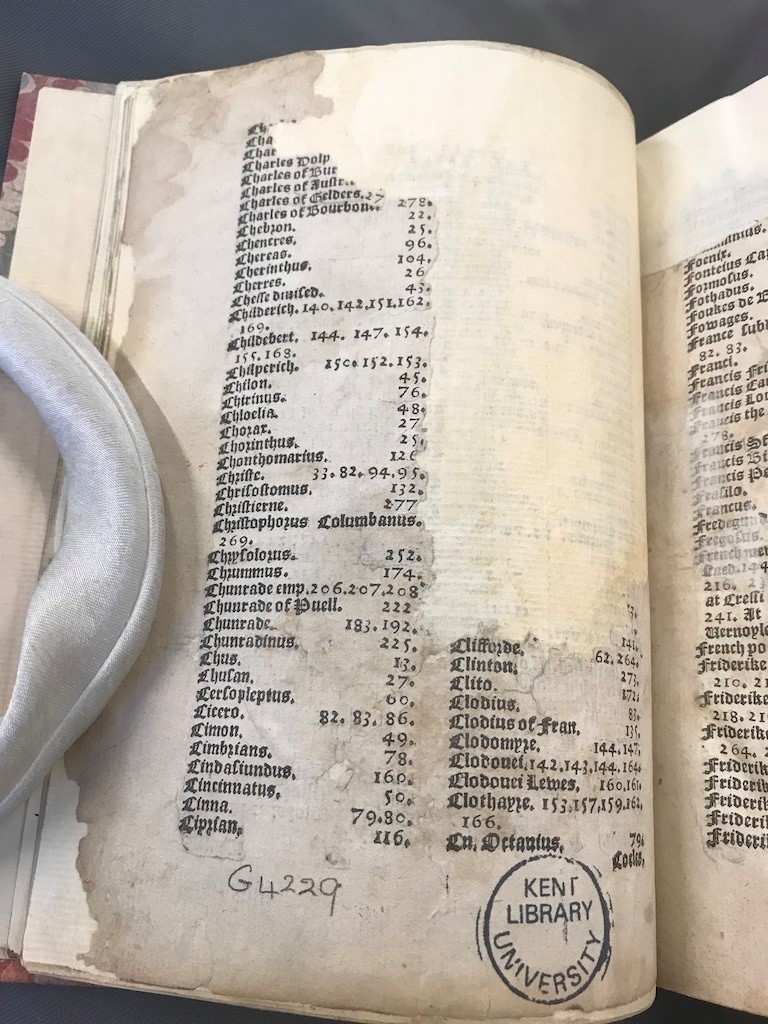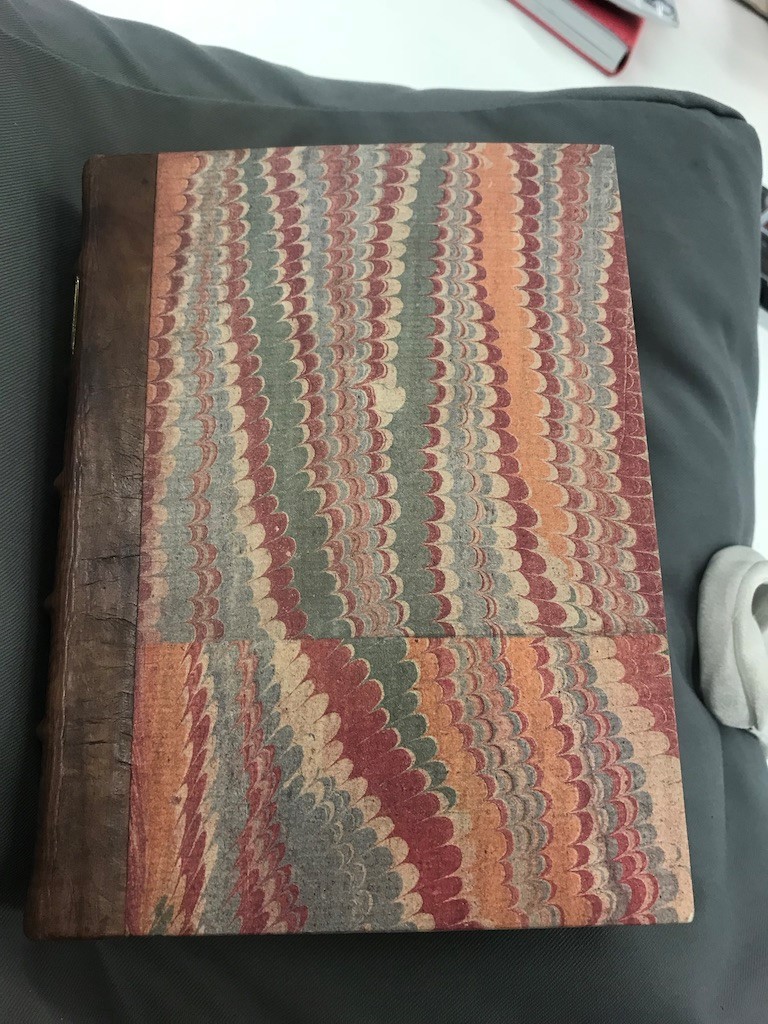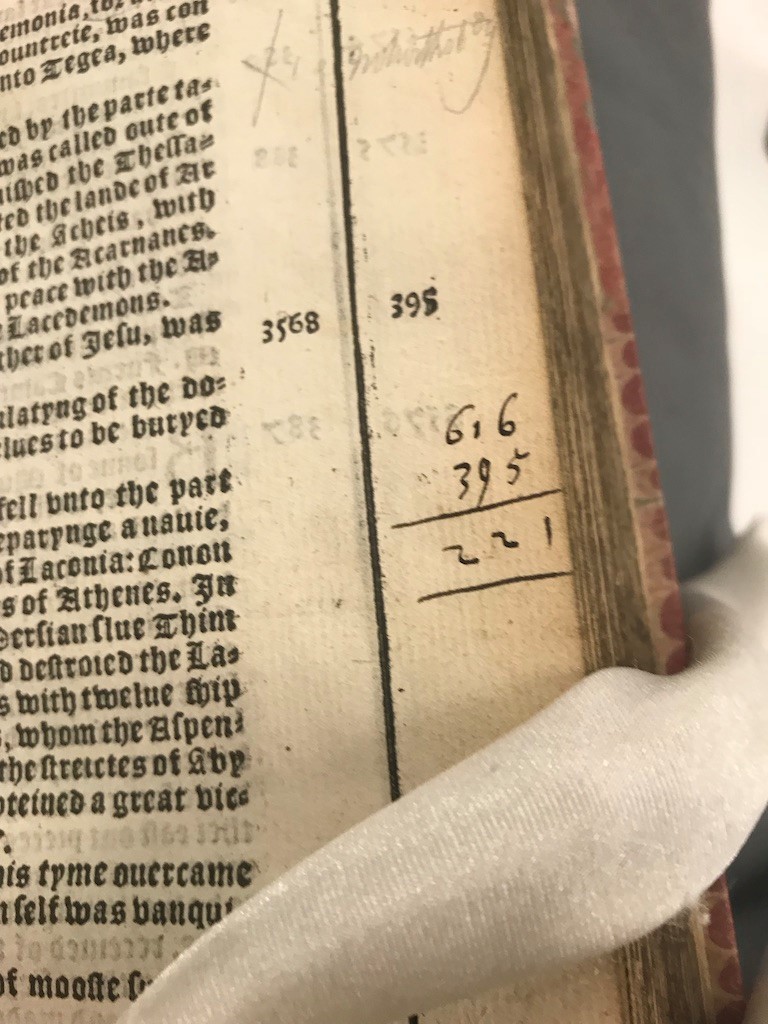Written by Bex Norris, student on HI6062: Dynasty, Death and Diplomacy – England, Scotland & France 1503 – 1603
Little is actually known about Thomas Lanquet’s life, except that he began writing his Epitome of Chronicles, but he died before it was finished. The Chronicles werefinished by Thomas Cooper and published in 1549, with the book later being known as the Coopers Chronicle. Lanquet died in 1545 after writing about the accession of Tiberius, with the rest of the book being written by Cooper. Despite the fact that very little is known about Lanquet himself, it is known that he was a historian and a humanist, which would suggest that he would have styled his work to mimic Classical literature, something seen as contemporarily popular.
The copy of An Epitome of Chronicles held at Special Collections & Archives at the Templeman Library is interesting for several reasons. The book has been rebound and several pages of the beginning on the book have been replaced, most likely due to water damage, as seen in the images below. The newer elements of the book seem to have been replaced in the nineteenth or twentieth century. This is also seen with some pages where the original paper has remained partially intact, with the damaged elements being replaced with newer paper, as seen in the images below. This is something that is therefore unique to this copy of An Epitome of Chronicles and gives a clear idea that the book was not left in the best condition, potentially being left in a damp storage area that would have degraded these elements of the book to the point of needing replacing. [Editor’s note: this damage did not occur in the book’s current home!]
Another interesting feature that is unique to this copy of Epitome of Chronicles is the fact it has been annotated. This is indicative that a previous owner of the book did not feel that it was important enough to remain unmarked, with one page containing a sum, which appears to be to do with the chronology of the history. This highlights the use and engagement with the book, as they were able to read well enough that they felt that they were able to annotate certain sections and to add their own thoughts. This suggests that the book was owned by a literate person who was able to write down what they thought of particular passages, giving an insight in to their responses from when they read the book.
The work of Lanquet, and subsequently Cooper was to educate readers on the history of England as they saw it, with references to what was happening in the wider world. This would include who was ruling in other countries and if there were any plagues within countries, such as a pestilence in 491 B.C. in Rome. It is accepted within the writing that the Bible and Arthurian legend are history, and this is used to emphasise the chronology he was writing. Cooper, however, changes Arthurian legends to suit the history he wanted to tell, removing magic from his chronicles and replacing it with the power of the ‘common voice of the people’. Magic being removed when writing the histories would have been not only to make them a realistic part of history, but also because Cooper, who finished the chronicle, was a bishop, and the use of magic would not have fallen in line with his religious views. The histories therefore would have been adapted to suit the narrative that the authors would have believed in, as well as any political leanings that they may have had, which is shown with how the book is dedicated to Prince Edward and the Duke of Somerset. This highlights how Cooper would have been attempting to praise the prince, while affirming Protestant beliefs, with Cooper stating in the preface, ‘the holy scriptures […] teaches us politicall administracion, and let forth many notable examples, which in rulying a publike weal be necessary to bee knowen, and whereby the myndes of princis may bee stiered to the study of true nobilitee and vertue’. This explains why not only the biblical history is accepted as fact and dated within the chronicle, but also why it is so supportive towards the Tudors and how they are favoured by God. The fact that the book is also written in English, in a Gothic font, further highlights the break from Rome, as Lanquet and Cooper did not write in Latin, with English books being more common following the Reformation.
The preface not only gives an idea of the setting in which the book was written in, but also the type of person it was written for. As ‘the readyng of histories doth indifferently avayle all men’ and ‘Princis, yea and all other, that have auctoritee in great affaires and high matters, ought those examples and actes chiefly to consider’ suggest that Lanquet and Cooper believed that the main audience of their book would be those in a position of political power, and that history would be useful in knowing where previous leaders have failed and how they have succeeded.
Even though little is known about Thomas Lanquet, quite a lot can be discerned about England during his time from this single copy of An Epitome of Chronicles, with language choices giving an indication of the context that the book was written in, and additions to the book with owners’ notes giving a sense of the history of this particular copy of An Epitome of Chronicles. The book is unique to other copies because of its treatment since its publication in 1549, making it an interesting centrepiece for research, seen even in the past with different copies of the book. The way in which the book has been treated, such as the rebinding of the book because of its damage makes this copy unique to any others. The copy of Lanquet’s Epitome of Chronicles held in the Templeman Library is therefore interesting based on not only the history of England that it gives, but also in how it differs from other copies
Bibliography
Primary Sources
Lanquet, Thomas and Thomas Cooper, An Epitome of Chronicles [London: Thomas Berthelet, 1549] Special Collections & Archives: Pre-1700 Collection, C 549 LAN
Lanquet, Thomas and Thomas Cooper, ‘An Epitome of Chronicles’, Early English Books Online, <http://gateway.proquest.com/openurl?ctx_ver=Z39.88-2003&res_id=xri:eebo&rft_id=xri:eebo:image:176476> [accessed 31 October 2018]
Secondary Sources
Fletcher, Robert Huntington, The Arthurian Material in the Chronicles Especially Those of Great Britain and France (New York, NY: Haskell House, 1965)
H., C. W., ‘Queries with Answers’, Notes and Queries, 3rd ser., 11 (1867), 332-333
Pearson, David, John Mumford and Alison Walker, ‘Understanding and caring for bookbindings’, British Library Preservation Advisory Centre, <https://www.bl.uk/aboutus/stratpolprog/collectioncare/publications/booklets/caring_for_bookbindings.pdf> [accessed 30 October 2018]
Starnes, D. T., ‘Sir Thomas Elysot and the Lanquet-Cooper “Chronicle”’, The University of Texas Studies on English, 34 (1955), 35-42
Summerson, Henry, ‘Lanquet, Thomas’, Oxford Dictionary of National Biography, <http://www.oxforddnb.com/view/10.1093/ref:odnb/9780198614128.001.0001/odnb-9780198614128-e-16056?rskey=e3o07u&result=1> [accessed 29 October 2018]
Wheatley, Chloe, Epic, Epitome, and the Early Modern Historical Imagination (Farnham: Ashgate, 2011)




